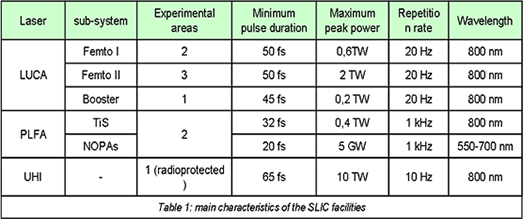SLIC LASER Facilities
The three main SLIC facilities, respectively named LUCA, PLFA and UHI, have all been designed to produce intense, ultrashort pulses but are optimised for complementary applications. Their main characteristics are summarised in Table 1. LUCA is a 20Hz multi-line (up to 6) and multi-user (up to 4) facility with peak power up to 1TW. LUCA features an extraordinary reliability leading to an availability rate of 90% over the 2004-2008 period. It also offers permanent advanced experimental set-ups for femtochemistry and solid-state physics experiments along with a XUV line based on harmonic generation in gases. Pulse energy up to 1µJ in the 46-60 nm range is available. PLFA delivers 0,4TW pulses at 1kHz repetition rate. Mostly dedicated to experiments requiring high average flux and high pulse to pulse stability, PLFA will be preferred whenever low signal to noise ratios are anticipated. Finally, UHI is our most intense laser: it delivered 10TW pulses from 1997 to 2007 and is presently undergoing an upgrade to provide 100TW pulses. UHI is also characterised by its high temporal contrast (1010). Particle acceleration and harmonic generation on plasma mirrors are typical examples of experiments carried out at UHI.
LUCA, PLFA and UHI have numerous common technical features. They are all based on the Chirped Pulse Amplification (CPA) scheme and are all using Titanium-Sapphire (TiS) as the laser medium. Their stretchers are designed according to the aberration balanced Öffner design. Their first amplification stages are regenerative amplifiers. The number of amplifiers varies from 3 (LUCA and PLFA) to 5 (UHI). Finally, optimal pulse compression is achieved using gratings with higher groove density in the compressor than in the stretcher and programmable acousto-optics filters (DAZZLER by FASTLITE Company) to compensate for any residual spectral phase distortions.
A complete line of diagnostics is available on all SLIC facilities to provide online characterization of the main laser parameters. In particular, spatial characteristics can be monitored using beam- and wavefront- analysers whereas the temporal pulse properties can be analysed using in-house developed autocorrelators, high dynamic cross-correlator and SPIDERs. In addition, optical benchtests are available to investigate the properties of optical components in terms of surface quality and reflectivity as a function of wavelength.
Access can also be offered on SOFOCKLE and UpConversion. SOFOCKLE, which provides 40fs, 700µJ pulses at 1 kHz, is extremely convenient for preparing experiments or testing new diagnostics. The UpConversion laboratory offers a rare set-up for the study of femtosecond time-resolved emission spectra of molecules in the condensed phase. SOFOCKLE and Upconversion are operated by C. Cornaggia (SPAM/MEC/AttoPhysics) and T. Gustavsson (SPAM/LFP) respectively.




